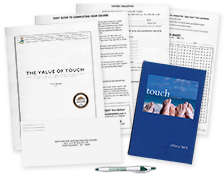7 Hour CE Course

Do you have the Touch textbook? See your enrollment options above for "I already own the text".
Based on a book written by Tiffany Field, PhD, the Director of the Touch Research Institute at the University of Miami School of Medicine, this course examines the value of touch from sociological, anthropological and physiological perspectives and presents recent significant research results on a variety of touch therapies.
| Touch as Hunger | 0.75 hour |
| Touch as Communication | 0.75 hour |
| Touch in Development | 0.75 hour |
| Touch Deprivation | 0.75 hour |
| Touch Message to the Brain | 0.75 hour |
| Touch Therapies | 0.75 hour |
| Infant Massage | 0.75 hour |
| Massage Therapy for Children, Adolescents and Adults | 1 hour |
| References | |
| Open-Book Test and Course Evaluation | 0.75 hour |
"We also learned that we could predict postpartum depression by asking, "Do you and your partner want this baby?" From our own research, we now know that postpartum depression, affecting as much as 80 percent of women, has terrible effects on newborns. Babies born to depressed mothers show inferior performance on the Brazelton Neonatal Behavior Assessment, an examination that assesses the newborn's response to visual, auditory, social, and nonsocial stimulation, and the newborn's motor behavior, self-quieting, and reflexes. These newborns are also less attentive and less responsive to faces, and their perception of auditory, tactile, and visual stimuli is less developed. In addition, their EEG activity is similar to that of their adult mothers. The differences at this early stage probably derive from these babies having been exposed to their mother's high levels of stress hormones during pregnancy, because at birth the newborns have the same high stress-hormone levels as their mothers. After their birth, the depressed mothers touched their newborns less often than the nondepressed mothers. When a mother's depression continues, the infant's growth and development are delayed. If the mother is still depressed six months after the delivery, the infant typically weighs less than the norm, and at one year has lower Bayley mental and motor scale scores." (Touch by Tiffany Field, 2001, p. 42-43)
Postpartum depression:


Take our free online course: Ethics Refresher
We will not rent/sell your email to anyone.
You'll also receive our newsletter and special offers.
Thank you! An email will be sent to the address provided with instructions on how to enroll in this 1 CE hour course - FREE!
If you do not see our email within a few minutes of signing up, please check your Spam/Junk folders it may have been delivered there instead of your inbox.
If, by chance, you still have not received it within 5 minutes, please call us at 1-800-364-5722, Monday-Friday, 9am-5pm EST for assistance.